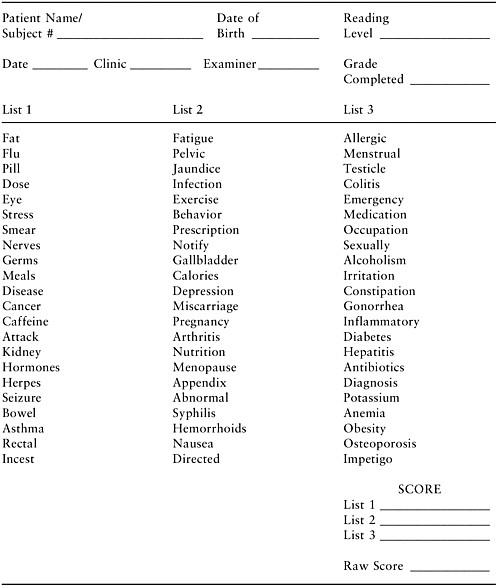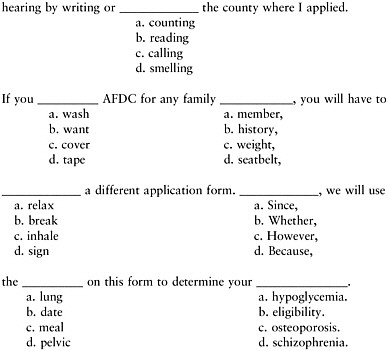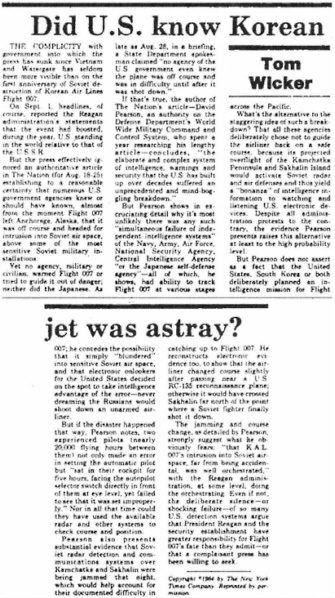C
Sample Material from Selected Assessments of Literacy and Health Literacy
This appendix presents background and sample items from some of the measures that have been discussed in this report. For more information about the development and use of these measures, please see Chapter 2.
CONTENTS
Directions:
-
Give the patient a laminated copy of the REALM and score answers on an unlaminated copy that is attached to a clipboard. Hold the clipboard at an angle so that the patient is not distracted by your scoring procedure. Say:
“I want to hear you read as many words as you can from this list. Begin with the first word on List 1 and read aloud. When you come to a word you cannot read, do the best you can or say “blank” and go on to the next word.”
-
If the patient takes more than five seconds on a word, say “blank” and point to the next word, if necessary, to move the patient along. If the patient begins to miss every word, have him or her pronounce only known words.
-
Count as an error any word not attempted or mispronounced. Score by marking a plus (+) after each correct word, a check (
 ) after each mispronounced word, and a minus (–) after words not attempted. Count as correct any self-corrected word.
) after each mispronounced word, and a minus (–) after words not attempted. Count as correct any self-corrected word. -
Count the number of correct words for each list and record the numbers in the “SCORE’ box. Total the numbers and match the total score with its grade equivalent in the table below (Table C-2).
TABLE C-2 Scores and Grade Equivalents for the REALM
|
GRADE EQUIVALENT |
|
|
Raw Score |
Grade Range |
|
0–18 |
3rd Grade and below
|
|
19–44 |
4th to 6th Grade
|
|
45–60 |
7th to 8th Grade
|
|
61–66 |
High School
|
Excerpts taken from: Davis TC, Crouch MA, Long SW. 1993. Rapid Estimate of Adult Literacy in Medicine: A Shortened Screening Instrument. Louisiana State University. Reprinted with permission.
EXCERPTS FROM THE TEST OF FUNCTIONAL HEALTH LITERACY IN ADULTS
Numeracy
The numeracy section of the TOFHLA measures the patient’s ability to understand and act on numerical directions given by a health-care provider or pharmacist. The test items reproduce real-life situations in receiving, following, and paying for medication plans. The numeracy section uses a series of prompts to which the patient responds. These prompts consist of prescription vials, an appointment slip, a chart describing eligibility for financial aid, and an example of results from a medical test. The patient is handed the prompt for each question, the administrator reads each question, and the responses are recorded.
Sample Items
At the beginning of this section, the following introduction is read: “These are directions you or someone else might be given at the hospital. Please read each direction to yourself. Then I will ask you some questions about what it means.” For the first few questions in this section the patient is given Prompt 1, a prescription bottle that has the label shown in Figure C-1 below taped to it.
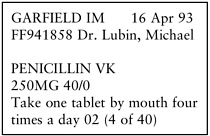
FIGURE C-1 Prompt 1 for TOFHLA. Prescription label that should taped onto an actual prescription bottle that can be handed to the patient to read.
Questions for Prompt 1:
If you take your first tablet at 7:00 am, when should you take the next one?
And the next one after that?
What about the last one for the day, when should you take that one?
At the end of the numeracy section, the patient is given Prompt 10, a laminated card with information shown in Figure C-2 below.

FIGURE C-2 Prompt 10 for TOFHLA. Laminated card with financial information about clinic services.
Question for Prompt 10:
Let’s say that after deductions, your monthly income and other resources are $1,129. And, let’s say you have 3 children. Would you have to pay for your care at that clinic?
Reading Comprehension
The reading comprehension section of the TOFHLA measures a patient’s ability to read passages using real materials from the health-care setting using a modified Cloze procedure. Passages included come from instructions for preparation for an upper GI series, the patient rights and responsibilities section of a Medicaid application form, and standard hospital informed consent language.
Sample Items
At the beginning of the reading comprehension section of the TOFHLA, the following instructions are read:
Here are some other medical instructions that you or anybody might see around the hospital. These instructions are in sentences that have some of the words missing. Where a word is missing, a blank line is drawn, and 4 possible words that could go in the blank appear just below it. I want you to figure out which of those 4 words should go in the blank, which word makes the sentence make sense. When you think you know which one it is, circle the letter in front of that word, and go on to the next one. When you finish the page, turn the page, and keep going until you finish all the pages.
The reading comprehension section consists of three passages; one of these passages is shown on the next page.
EXCERPTS FROM THE NATIONAL ADULT LITERACY SURVEY
Prose Literacy and Sample Items
Prose refers to any written text such as editorials, news stories, poems, and fiction, and can be broken down into two types: expository prose and narrative prose. Expository prose consists of printed information that defines, describes, or informs, such as newspaper stories or written instructions. Narrative prose tells a story. Prose varies in its length, density, and structure (e.g., use of section headings or topic sentences for paragraphs). Prose literacy tasks include locating all the information requested, integrating information from various parts of a passage of text, and writing new information related to the text.
Prose Literacy Levels
Adults included in level 1 were those who could succeed at level 1 tasks, but not at level 2 tasks, as well as those who could not succeed at level 1 tasks and those who were not literate enough in English to take the test at all. Adults in levels 2 through 4 were able to succeed at tasks at their proficiency level, but not at tasks for the next more difficult level. Adults in level 5 are able to succeed at level 5 tasks.
Prose Level 1. Level 1 prose literacy tasks required a person to read a short passage of text and locate a single piece of information that is identical to or synonymous with the information given in the question. If plausible but incorrect information was present in the text, it tended not to be located near the correct information.
Sample Prose Item (Level 1): Swimmer Article: Locate Fact with No Distractor
Task: Use the article “Swimmer completes Manhattan marathon” (See Figure C-3) to answer the following question.
Underline the sentence that tells what Ms. Chanin ate during the swim.
The answer is correct if respondent underlines, circles, or puts a mark next to the sentence beginning A Spokesman for the Swimmer, or underlines, circles, or puts a mark next to any part of the sentence that just lists the foods.
This level 1 task asks respondents to read a newspaper article about a marathon swimmer and to underline the sentence that tells what she ate
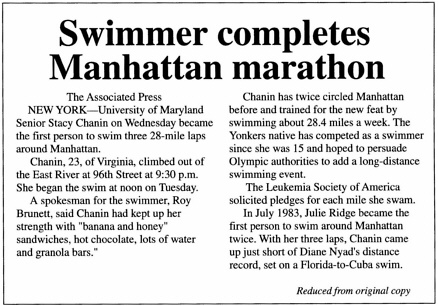
FIGURE C-3 Article “Swimmer completes Manhattan marathon” used in NALS.
during a swim. Only one reference to food is contained in the passage, and it does not use the word “ate.” Rather, the article says the swimmer “kept up her strength with banana and honey sandwiches, hot chocolate, lots of water and granola bars.” The reader must match the word “ate” in the directive with the only reference to foods in the article.
Prose Level 2. Prose literacy tasks at level 2 required a person to locate a single piece of information in the text, compare and contrast easily identifiable information based on criteria provided in the question, or integrate two or more pieces of information, when distractors were present or when low level inferences were required.
Sample Prose Item (Level 2): Swimmer Article: Locate Fact with Distractor
Task: Use the article “Swimmer completes Manhattan marathon” (see Figure C-3 above) to answer the following question.
At what age did Chanin begin swimming competitively?
Acceptable responses are underlining or circling age or the sentence containing the age in the article.
This level 2 task requires the reader to locate information in the text. The reader is asked to identify the age at which the marathon swimmer began to swim competitively. The article first provides the swimmer’s current age of 23, which is a plausible but incorrect answer. The correct information, age 15, is found toward the end of the article.
Prose Level 3. Prose literacy tasks at level 3 required a person to match literal or synonymous information in the text with that requested in the question, to integrate multiple pieces of information from dense or lengthy text, or to generate a response based on information that could be easily identified in the text. Distracting information was present, but was not located near the correct information.
Sample Prose Item (Level 3): Discrimination Article
Task: Refer to the article below (Figure C-4) to answer this question.
List two things that Chen became involved in or has done to help resolve conflicts due to discrimination.
The answer is correct if the respondent lists any two of the following:
-
worked for EEO Commission or was litigator on behalf of plaintiffs who experienced discrimination
-
served on Philadelphia Commission on Human Relations or worked with community leaders (to resolve racial and ethnic tensions)
-
contributed free legal counsel (to a variety of activist groups)
-
called for a meeting of community leaders to help resolve conflict over desecration of Korean street signs
-
involved in Hispanic, Jewish, and black issues
-
involved in Ethnic Affairs Committee of Anti-Defamation League of B’nai B’rith or just B’nai B’rith
This level 3 item requires the reader to read a magazine article about an Asian-American woman and to provide two facts that support an inference made from the text. The question directs the reader to identify what Ida Chen did to help resolve conflicts due to discrimination.
Prose Level 4. Prose literacy tasks at level 4 required a person to search through text and match multiple features, and to integrate or synthesize multiple pieces of information from complex or lengthy passages. More complex inferences were required, and conditional information had to be taken into consideration for these tasks.
Sample Prose Item (Level 4): Korean Jet Article
Task: This question directs the reader to state what argument Tom Wicker is making in the editorial below (Figure C-5).
In this level 4 item, the answer is correct if the argument is identified and respondents make a statement about the author’s main point. Answers were marked incorrect if the argument was not identified, respondents wrote what the article was about, or listed evidence without stating the argument. Answers that used the prompt as a basis for personal digression were also marked incorrect. The item is reflective of other tasks at this level of difficulty, which often have repetitive statements that are elaborated in the text so that the propositions supporting the theme, though repetitive, are widely separated in the text.
Prose Level 5. Prose literacy tasks at level 5 required a person to search through text and match multiple features contained in dense text with a number of plausible distractors, to compare and contrast complex information, or to generate new information making high-level inferences or using specialized background knowledge.
Document Literacy and Sample Items
Documents are short forms or graphically displayed information found in everyday life, including job applications, payroll forms, transportation schedules, maps, tables, and graphs. Document literacy tasks included locating a particular intersection on a street map, using a schedule to choose the appropriate bus, or entering information on an application form.
Document Literacy Levels
Adults included in level 1 were those who could succeed at level 1 tasks, but not at level 2 tasks, as well as those who could not succeed at level 1 tasks and those who were not literate enough in English to take the test at all. Adults in levels 2 through 4 were able to succeed at tasks at their proficiency level, but not at tasks for the next more difficult level. Adults in level 5 are able to succeed at level 5 tasks.
Document Level 1. Document literacy tasks at level 1 required a person to locate information based on a literal match to the question or to enter information from personal knowledge into a document. Little, if any, distracting information was present.

FIGURE C-6 Job application used in NALS.
Sample Document Item (Level 1): Job Application (Figure C-6)
Task:
The answer is correct if the respondent satisfactorily completes the form portion (birth date, age, sex, height, weight, health, grade).
In this task, readers were asked to complete a section of a job application by providing several pieces of information. Here, respondents had to conduct a series of one-feature matches.
Sample Document Item (Level 1): Net Pay
Task: Here is a wage and tax statement that comes with a paycheck (Figure C-7). What is the current net pay?
The correct answer to this item is: 459.88.
This level 1 question asks, “what is the current net pay?” Since the term appears only once on the pay stub and there is only one number in the column, this task requires only a one-feature match and receives a difficulty value that lies within the level 1 range on the document scale.
Document Level 2. Document literacy tasks at level 2 required the reader to match a piece of information either when several distractors were present
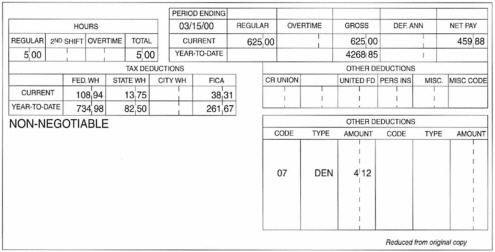
FIGURE C-7 Wage and tax statement used in NALS.
or when low-level inferences were required. Tasks at this level also asked the reader to cycle through information in a document or to integrate information from various parts of a document.
Sample Level 2 Item
Task: You are a marketing manager for a small manufacturing firm. This graph (Figure C-8) shows your company’s sales over the last three years. Given the seasonal pattern shown on the graph, predict the sales for Spring 1985 (in thousands) by putting an “x” on the graph.
The answer is correct if the respondent puts an “x” or other mark on the graph at any point above the point for Winter, 1984, in the area under 1985.
This level 2 task asks respondents to study a line graph showing a company’s seasonal sales over a three-year period, then predict the level of sales for the following year, based on the seasonal trends shown in the graph. It requires readers to integrate information from different parts of the document by looking for similarities or differences.
Document Level 3. Document literacy tasks at level 3 required a person to integrate multiple pieces of information from one or more documents. Other tasks asked readers to cycle through complex tables or graphs and locate particular features. The displays contained information that was irrelevant or inappropriate to the task.
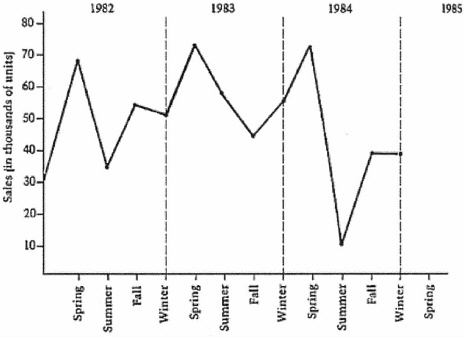
FIGURE C-8 Sales graph used in NALS.
Sample Level 3 Item: Energy Chart (Figure C-9)
Question: In the year 2000, which energy source is predicted to supply a larger percentage of total power than it did in 1971?
-
Coal
-
Petroleum
-
Natural Gas
-
Nuclear Power
-
Hydropower
-
I don’t know
The correct answer to this item is: D. Nuclear power.
This level 3 task directs the reader to a stacked bar graph depicting estimated power consumption by source for four different years. The reader is asked to select an energy source that will provide a larger percentage of total power in the year 2000 than it did in 1971. To succeed on this task, the reader must first identify the correct years and then compare each of the five pairs of energy sources given.
Document Level 4. Document literacy tasks at level 4 required a person to perform multiple-feature matches, cycle through documents, and integrate

FIGURE C-9 Energy chart used in NALS.
SOURCE: U.S. Department of Interior United States Energy through the year 2000.
BTU: Quantity of heat required to raise temperature of one pound of water one degree Fahrenheit.
Copyright 1973 Congressional Quarterly Inc.
information, all of which required high-level inferences. Many of these tasks required readers to provide numerous responses but did not designate how many responses were needed. Conditional information was also present in the tasks at this level and had to be taken into account by the reader.
Sample Level 4 Item: Bus Schedule (Figure C-10)
On Saturday afternoon, if you miss the 2:35 bus leaving Hancock and Buena Ventura going to Flintridge and Academy, how long will you have to wait for the next bus?
The correct answer to this item is: C. Until 3:35 p.m.
This level 4 task combines many of the variables that contribute to difficulty in level 5. These include multiple feature matching, complex dis-
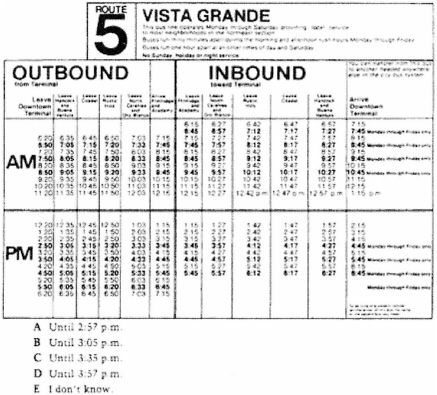
FIGURE C-10 Bus schedule used in NALS.
plays involving nested information, numerous distracters, and conditional information that must be taken into account in order to arrive at a correct response. Using the bus schedule, readers are asked to select the time of the next bus on a Saturday afternoon, if they miss the 2:35 bus leaving Hancock and Buena Ventura going to Flintridge and Academy. Several departure times are given, from which respondents must choose the correct one.
Document Level 5. Document literacy tasks at level 5 required a person to search through complex displays that contained multiple distractors, to make high-level text-based inferences, and to use specialized knowledge. Tasks required readers to integrate information, compare and contrast data points, and to summarize the results.
Quantitative Literacy and Sample Items
Quantitative information may be displayed visually in graphs or charts or in numerical form using whole numbers, fractions, decimals, percent-
ages, or time units (hours and minutes). These quantities appeared in both prose and document form. Quantitative literacy refers to locating quantities, integrating information from various parts of a document, determining the necessary arithmetic operation, and performing that operation. Quantitative literacy tasks included balancing a checkbook, completing an order form, and determining the amount of interest paid on a loan.
Quantitative Literacy Levels
Adults included in level 1 were those who could succeed at level 1 tasks, but not at level 2 tasks, as well as those who could not succeed at level 1 tasks and those who were not literate enough in English to take the test at all. Adults in levels 2 through 4 were able to succeed at tasks at their proficiency level, but not at tasks for the next more difficult level. Adults in level 5 are able to succeed at level 5 tasks.
Quantitative Level 1. Quantitative literacy tasks at level 1 required a person to perform single, relatively simple arithmetic operations, such as addition, when the question included the numbers to be used and the arithmetic operation to be performed.
Sample Quantitative Item (Level 1): Adding Deposits (Figure C-11)
Task: You wish to use the automatic teller machine at your bank to make a deposit. Figure the total amount of the two checks being deposited. Enter the amount on the form in the space next to TOTAL.
The correct answer to this item is $632.19.
This level 1 item is the least demanding task on the quantitative scale. It requires the reader to total two numbers on a bank deposit slip. In this task, both the numbers and the arithmetic operation are judged to be easily identified and the operation involves the simple addition of two decimal numbers that are set up in column format.
Quantitative Level 2. Quantitative literacy tasks at level 2 required a person to locate numbers by matching the required information with that given, infer the necessary arithmetic operation, or perform an arithmetic operation when the tasks specified the numbers and the operation to be performed. The quantities could be easily located in the text, and the operation could be determined from the format of the material.
Quantitative Level 3. Quantitative literacy tasks at level 3 required a person to locate numbers by matching the required information with that given, infer the necessary arithmetic operation and perform arithmetic operations
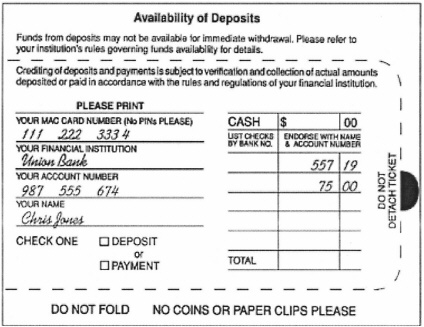
FIGURE C-11 Bank deposit slip used in NALS.
on two or more numbers, or to solve a problem, when the numbers must be located in the text or document. The required operation(s) could be determined from the arithmetic-relation terms used in the question.
Quantitative Level 4. Quantitative literacy tasks at level 4 required a person to perform two or more sequential arithmetic operations or a single arithmetic operation, when the quantities could be found in different displays, or when the operations had to be inferred from semantic information given or drawn from prior knowledge.
Sample Quantitative Item (Level 4): Unit Price (Figure C-12)
Task: Estimate the cost per ounce of the creamy peanut butter. Write your estimate on the line provided.
The correct answer to this item is: Any figure from 9 (.09) to 10 (.10).
This level 4 item task requires the reader to select from two unit price labels to estimate the cost per ounce of creamy peanut butter. To perform this task successfully, readers may have to draw some information from prior knowledge.
Level 4 tasks require either two sequential operations or the application
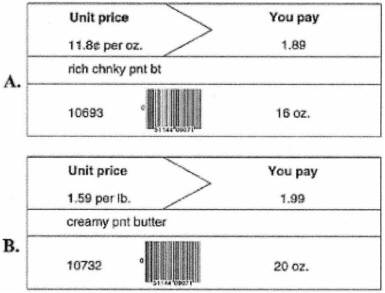
FIGURE C-12 Peanut butter label used in NALS.
of a single higher level operation, such as multiplication. In this example, readers are shown a menu and are required to compute the cost of a specified meal and use multiplication to determine a ten percent tip.
Quantitative Level 5. Quantitative literacy tasks at level 5 required a person to perform multiple arithmetic operations sequentially, when the features of the problem had to be extracted from text; or when background knowledge was required to determine the quantities or operations needed.
Sample Quantitative Item (Level 5): Interest Charges (Figure C-13)
Task: Use the ad for Home Equity Loans to answer this question.
You need to borrow $10,000. Explain to the interviewer how you would compute the total amount of interest charges you would pay under this loan plan. Please tell the interviewer when you are ready to begin.
The answer is correct if the speaker explains the two basic steps in computing the total interest charges, i.e., the monthly payment ($156.77) times the number of payments (120) equals the total loan payment; the
total loan payment minus the amount of the loan ($10,000) equals the total interest charges.
One of the most difficult tasks on the quantitative scale, this item requires readers to look at an advertisement for a home equity loan and then, using the information given, explain how they would calculate the total amount of the interest charges associated with the loan.
Excerpts taken from: National Center for Education and Statistics, U.S. Department of Education. Defining Literacy and Sample Items. [Online]. Available: http://nces.ed.gov/naal/defining/defining.asp [accessed: October, 2003].
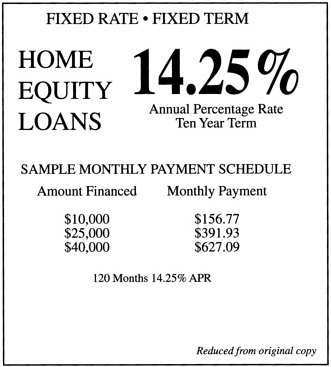
FIGURE C-13 Home equity loan advertisement used in NALS.

